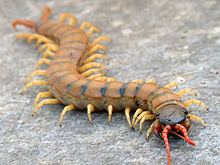Scolopendridae
| Scolopendridae Temporal range: Early Cretaceous to present
| |
|---|---|

| |
| Scolopendra cingulata | |
| Scientific classification | |
| Domain: | Eukaryota |
| Kingdom: | Animalia |
| Phylum: | Arthropoda |
| Subphylum: | Myriapoda |
| Class: | Chilopoda |
| Order: | Scolopendromorpha |
| Family: | Scolopendridae Newport, 1844 |
| Genera | |
|
See text. | |
Scolopendridae (or, in older documents, Scolopendridæ)[1] is a family of large centipedes (class Chilopoda).
Description
Nearly all species in this family have four ocelli (simple eyes) on each side of the head and only 21 pairs of legs, but there are exceptions: two scolopendrid species feature more legs (Scolopendropsis bahiensis, with 21 or 23 leg pairs,[2] and S. duplicata, with 39 or 43 leg pairs),[3] and some scolopendrid species are eyeless and blind (e.g., Cormocephalus sagmus, C. pyropygus, and C. delta).[4][5] Three Asian members of this family, Scolopendra cataracta, Scolopendra paradoxa, and Scolopendra alcyona, are known to show amphibious behaviour.[6][7][8][9][10][11] Two other species, Scolopendra hardwickei and Hemiscolopendra marginata, are known to show sexual dimorphism in the composition of their venom.[12][13]
Genera
Subfamily Otostigminae (Kraepelin, 1903)[14][15]
Tribe Otostigmini (Kraeplin, 1903)[16]
- Alipes Imhoff, 1854
- Alluropus Silvestri, 1911
- Digitipes Attems, 1930
- Edentistoma Tömösváry,1882
- Ethmostigmus Pocock, 1898
- Otostigmus Porat, 1876
- Rhysida Wood, 1862
Tribe Sterropristini (Verhoeff, 1937) [17][18]
- Sterropristes Attems, 1934
Subfamily Scolopendrinae (Leach, 1814)[19][14]
- Arthrorhabdus Pocock, 1891 (= Arthrorhabdinus)
- Asanada Meinert, 1885 (= Pseudocryptops)
- Asanadopsis Würmli, 1972
- Campylostigmus Ribaut, 1923
- Notiasemus Koch, 1985
- Procrytops Piton, 1940
- Psiloscolopendra Kraepelin, 1903
- Rhoda Meinert, 1886 (= Pithopus)
- Scolopendra Linnaeus, 1758
- Scolopendropsis Brandt, 1841
- Tonkinodentus Schileyko, 1992
The earliest record of this family is †Cratoraricrus, an extinct genus from the Early Cretaceous of the Crato Formation of Brazil.[20]
References
- ^ The Annals and magazine of natural history; zoology, botany, and geology. Vol. 7. London: Taylor and Francis, Ltd. 1891.
- ^ Schileyko, Arkady A. (2006). "Redescription of Scolopendropsis bahiensis (Brandt, 1841), the relations between Scolopendropsis and Rhoda, and notes on some characters used in scolopendromorph taxonomy (Chilopoda: Scolopendromorpha)". Arthropoda Selecta. 15 (1): 9–17 – via ResearchGate.
- S2CID 86220862.
- PMID 32476974.
- S2CID 209585200.
- ^ Anderson, Natali (2021-04-22). "Scientists Discover New Amphibious Species of Centipede | Sci.News". Sci.News: Breaking Science News. Retrieved 2022-09-06.
- ^ Holmes, O. (1 July 2016). "Giant swimming, venomous centipede discovered by accident in world-first". The Guardian. Retrieved 1 July 2016.
- ^ Bates, M. (26 June 2016). "'Horrific' First Amphibious Centipede Discovered". National Geographic. Archived from the original on June 26, 2016. Retrieved 1 July 2016.
- ^ Gravely, F.H. ″Two new species of Scolopendridae″, Records of the Indian Museum, Volume 7, 1912, p. 415
- PMID 27408540.
- ^ "Centipede". VEDANTU. Retrieved 2022-09-06.
- ^ Undheim, Eivind & Richards, David & Ngum, Neville & Tooth, David & Kim, Dong-Hyun & Mellor, Ian. (2019). When sex matters: Dramatic sexual dimorphism in the venom and venom system of the centipede Scolopendra hardwickei. Toxicon. 158. S5. 10.1016/j.toxicon.2018.10.024.
- S2CID 201644874.
- ^ a b "Scolopendridae Leach 1814 - Encyclopedia of Life". eol.org. Retrieved 2022-08-29.
- ^ "ITIS - Report: Otostigminae". www.itis.gov. Retrieved 2022-12-25.
- ^ "Otostigmini Kraepelin 1903". www.gbif.org. Retrieved 2022-12-25.
- ^ "Sterropristini Verhoeff 1937". www.gbif.org. Retrieved 2022-12-25.
- ISSN 1175-5334.
- ^ "ITIS - Report: Scolopendrinae". www.itis.gov. Retrieved 2022-08-29.
- ^ "Fossilworks: Cratoraricrus oberlii". fossilworks.org. Retrieved 17 December 2021.
External links
thumb ZAMN
